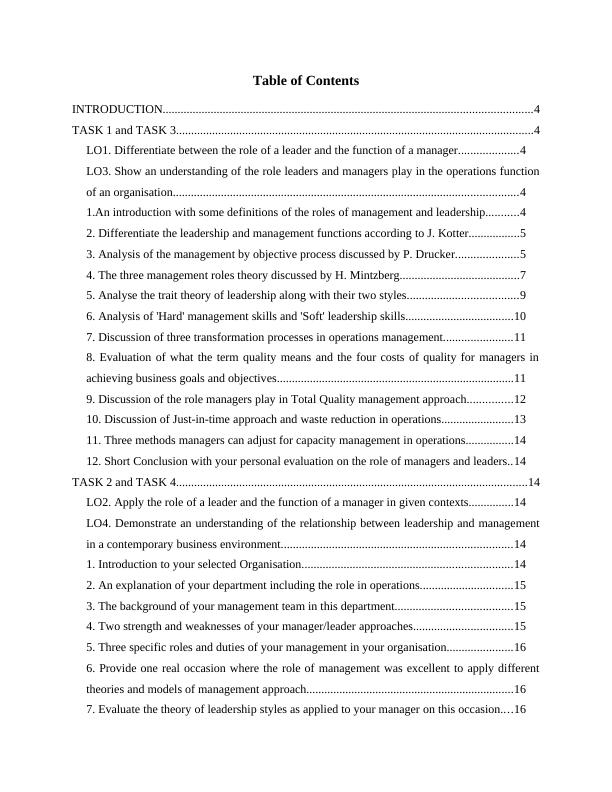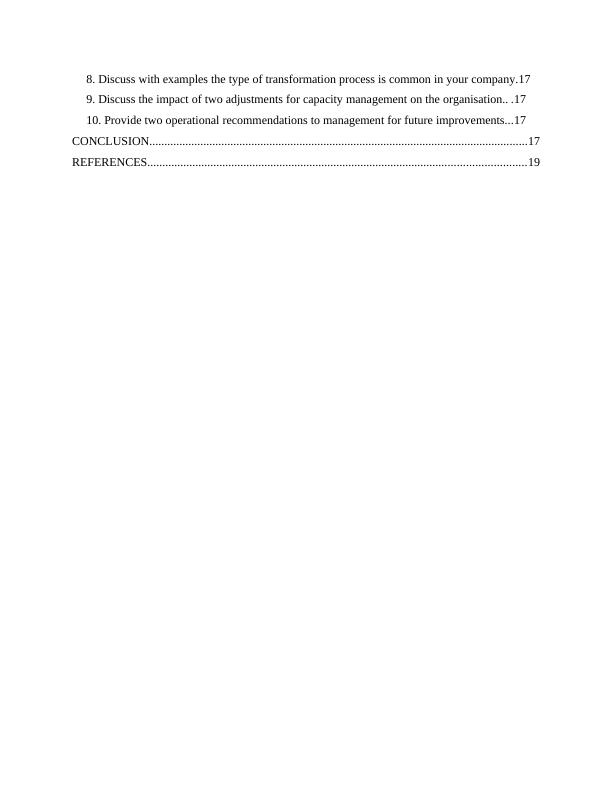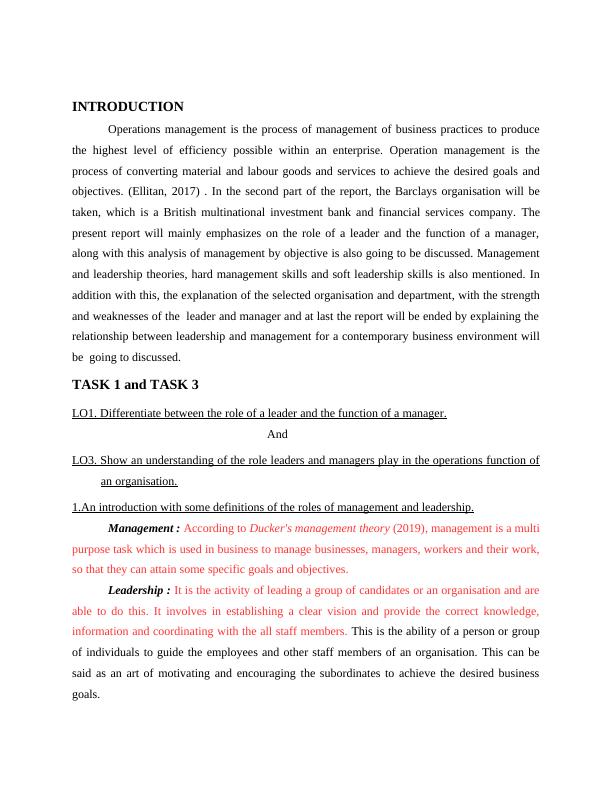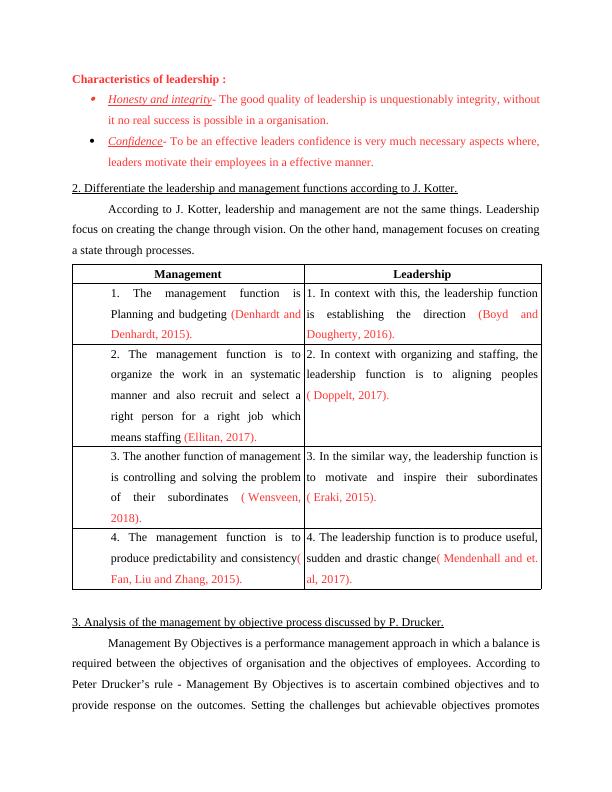Management & Operations - Total Quality Management
21 Pages6171 Words110 Views
Added on 2021-01-01
Management & Operations - Total Quality Management
Added on 2021-01-01
ShareRelated Documents
Management & Operations

Table of ContentsINTRODUCTION...........................................................................................................................4TASK 1 and TASK 3.......................................................................................................................4LO1. Differentiate between the role of a leader and the function of a manager....................4LO3. Show an understanding of the role leaders and managers play in the operations functionof an organisation...................................................................................................................41.An introduction with some definitions of the roles of management and leadership...........42. Differentiate the leadership and management functions according to J. Kotter.................53. Analysis of the management by objective process discussed by P. Drucker.....................54. The three management roles theory discussed by H. Mintzberg........................................75. Analyse the trait theory of leadership along with their two styles.....................................96. Analysis of 'Hard' management skills and 'Soft' leadership skills....................................107. Discussion of three transformation processes in operations management.......................118. Evaluation of what the term quality means and the four costs of quality for managers inachieving business goals and objectives...............................................................................119. Discussion of the role managers play in Total Quality management approach...............1210. Discussion of Just-in-time approach and waste reduction in operations........................1311. Three methods managers can adjust for capacity management in operations................1412. Short Conclusion with your personal evaluation on the role of managers and leaders..14TASK 2 and TASK 4.....................................................................................................................14LO2. Apply the role of a leader and the function of a manager in given contexts...............14LO4. Demonstrate an understanding of the relationship between leadership and managementin a contemporary business environment.............................................................................141. Introduction to your selected Organisation......................................................................142. An explanation of your department including the role in operations...............................153. The background of your management team in this department.......................................154. Two strength and weaknesses of your manager/leader approaches.................................155. Three specific roles and duties of your management in your organisation......................166. Provide one real occasion where the role of management was excellent to apply differenttheories and models of management approach.....................................................................167. Evaluate the theory of leadership styles as applied to your manager on this occasion....16

8. Discuss with examples the type of transformation process is common in your company.179. Discuss the impact of two adjustments for capacity management on the organisation.. .1710. Provide two operational recommendations to management for future improvements...17CONCLUSION..............................................................................................................................17REFERENCES..............................................................................................................................19

INTRODUCTIONOperations management is the process of management of business practices to producethe highest level of efficiency possible within an enterprise.Operation management is theprocess of converting material and labour goods and services to achieve the desired goals andobjectives. (Ellitan, 2017) . In the second part of the report, the Barclays organisation will betaken, which is a British multinational investment bank and financial services company.Thepresent report will mainly emphasizes on the role of a leader and the function of a manager,along with this analysis of management by objective is also going to be discussed. Managementand leadership theories, hard management skills and soft leadership skills is also mentioned. Inaddition with this, the explanation of the selected organisation and department, with the strengthand weaknesses of the leader and manager and at last the report will be ended by explaining therelationship between leadership and management for a contemporary business environment willbe going to discussed. TASK 1 and TASK 3LO1. Differentiate between the role of a leader and the function of a manager. AndLO3. Show an understanding of the role leaders and managers play in the operations function ofan organisation.1.An introduction with some definitions of the roles of management and leadership.Management : According to Ducker's management theory (2019), management is a multipurpose task which is used in business to manage businesses, managers, workers and their work,so that they can attain some specific goals and objectives.Leadership :It is the activity of leading a group of candidates or an organisation and areable to do this. It involves in establishing a clear vision and provide the correct knowledge,information and coordinating with the all staff members.This is the ability of a person or groupof individuals to guide the employees and other staff members of an organisation. This can besaid as an art of motivating and encouraging the subordinates to achieve the desired businessgoals.

Characteristics of leadership : Honesty and integrity- The good quality of leadership is unquestionably integrity, withoutit no real success is possible in a organisation. Confidence- To be an effective leaders confidence is very much necessary aspects where,leaders motivate their employees in a effective manner. 2. Differentiate the leadership and management functions according to J. Kotter.According to J. Kotter, leadership and management are not the same things. Leadershipfocus on creating the change through vision. On the other hand, management focuses on creatinga state through processes.ManagementLeadership1. The management function isPlanning and budgeting (Denhardt andDenhardt, 2015).1. In context with this, the leadership functionis establishing the direction (Boyd andDougherty, 2016).2. The management function is toorganize the work in an systematicmanner and also recruit and select aright person for a right job whichmeans staffing (Ellitan, 2017).2. In context with organizing and staffing, theleadership function is to aligning peoples(Doppelt, 2017).3. The another function of managementis controlling and solving the problemof their subordinates (Wensveen,2018).3. In the similar way, the leadership function isto motivate and inspire their subordinates( Eraki, 2015).4. The management function is toproduce predictability and consistency(Fan, Liu and Zhang, 2015).4. The leadership function is to produce useful,sudden and drastic change(Mendenhall and et.al, 2017).3. Analysis of the management by objective process discussed by P. Drucker.Management By Objectives is a performance management approach in which a balance isrequired between the objectives of organisation and the objectives of employees. According toPeter Drucker’s rule - Management By Objectives is to ascertain combined objectives and toprovide response on the outcomes. Setting the challenges but achievable objectives promotes

motivation and direction of employees. By increasing commitment, the opportunity is given tothe managers to focus on the new products which help to improve the performance of thecompany. The author has developed five steps to put MOB process into practice : Source : (Management by Objectives, 2018)1.Determine the organisational Objectives – The first step of any organisation is to buildtheir objectives, as they are the base from the mission and vision of an organisation(Drucker, 2018). If the objectives are not made by the company then there is no sense tofollow the next step.2.Translating the organisational objectives to employees – In order to achieve theobjectives, it is essential to translate that to the level of employees. So, for this PeterDrucker uses the concept of SMART goals (Specific, Measurable, Acceptable, Realisticand Time-Bound). These objectives must be recognized at all levels, so that eachemployee should know what are their responsibilities(Becerra-Fernandez and Sabherwal,2014).3.Stimulate the participation of employees in the determining of the objectives - Thefirst point to attain the objectives in effective manner is that; these objectives should bediscussed at all levels of the organisation so that everyone should know what is theirIllustration 1: Steps to practice the MOB process

End of preview
Want to access all the pages? Upload your documents or become a member.
Related Documents
Management and Operation HSBC Plclg...
|18
|5341
|296
Management and Operations Assignment Solved - Tesco Plclg...
|16
|5082
|166
Management & Operations INTRODUCTION 3 LO 1 & LO 3 3. Introduction to the role of management and leadershiplg...
|16
|5576
|420
Management & Operations - TXO system Ltd Assignmentlg...
|17
|5400
|29
Management & Operation Introduction 1lg...
|19
|5788
|386
Assignment on Operations Management - TESCOlg...
|19
|5361
|39
